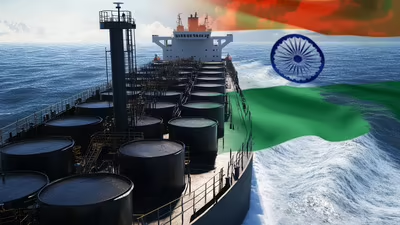Strait of Hormuz tensions have triggered fresh global alarm, as Iran’s recent vote to potentially shut down the world’s most critical oil chokepoint threatens to disrupt 20% of global crude supply — this escalation could deliver a costly blow, increasing import bills by over ₹25,000 crore, weakening the rupee, and fueling inflation across key sectors. While a full-scale blockade remains unlikely, even limited disruptions in the Strait of Hormuz could have deep economic consequences for India’s energy security and financial stability.
This comes on the heels of U.S. airstrikes on Iranian nuclear facilities on June 22, which pushed Brent crude up to $81 per barrel. Experts warn that even a limited disruption of the Strait—through drone attacks or mining routes—could push oil prices to $90–$100 per barrel, straining India’s fuel budget, trade deficit, and inflation control.
Why This Matters to India
The Strait of Hormuz handles 20% of global oil traffic. India, which imports over 85% of its crude oil, gets nearly 40% of it via Hormuz, including from key suppliers like Iraq, Saudi Arabia, UAE, and Kuwait.
If the strait faces even a partial closure, 1.5 to 2 million barrels per day of India’s supply could be delayed or rerouted. According to Petroleum Minister Hardeep Singh Puri, this would cost India an estimated ₹3,000–₹5,000 crore per week, depending on global oil price movements and route changes.
Rupee Impact: Fuel Costs, Forex, and Inflation
-
₹10–₹12 per litre fuel hike: If crude touches $90–$95 per barrel, petrol and diesel prices may rise by ₹10–₹12 per litre unless government subsidies are increased or taxes are adjusted.
-
₹25,000 crore+ import shock: With India importing around 5.5 million barrels per day, a $10 per barrel price rise adds ₹25,000 crore annually to the oil import bill.
-
Rupee may weaken by ₹2–₹3 against USD: A rise in import costs could push the Indian rupee down from ₹83.10 to as low as ₹85–₹86 per dollar, based on past RBI data trends.
-
0.5%–1% drop in GDP growth: Rising energy costs would directly impact manufacturing, logistics, and transport sectors, potentially pulling India’s projected GDP growth down to 6.2%–6.5% in FY26.
What About Oil Supply?
India is better prepared than before:
-
Strategic reserves cover 9–10 days of crude demand.
-
Oil marketing companies (like IOC, HPCL, BPCL) hold stocks for another 20–25 days.
-
India now imports over 40% of its crude from Russia via alternative sea routes, reducing exposure to Hormuz.
Import/Export of Crude Oil and Petroleum Products : See Details!
Still, if the crisis lasts longer than 30 days, stocks may run low, forcing India to buy more expensive oil from the US, Brazil, or Nigeria, adding to the freight and insurance burden.
Government Strategy
-
PM Modi has reportedly spoken with Iranian officials to avoid escalation.
-
Indian Navy is monitoring the Gulf region and may escort tankers through safer corridors.
-
The government may also tap strategic reserves or reduce excise duty temporarily if prices shoot up beyond tolerance levels.
Additionally, India is speeding up its renewable energy goals, aiming to reduce oil dependency over the next decade.
Global Context and Expert View
A 2023 report by the International Institute for Strategic Studies says Iran is unlikely to fully block Strait of Hormuz due to economic self-harm—it exports 96% of its oil via that route. Experts expect Iran to use drones or mines for temporary disruption, rather than a complete naval blockade.
But even minor interruptions may push insurance costs for tankers up by 25–30%, and cause shipping delays of 5–7 days, adding ₹1–₹2 per litre to India’s fuel costs at the pump.
Final Take: Stay Alert, Not Alarmed
While there is no full blockade yet, India must prepare for a short-term oil price shock. If tensions persist:
-
Fuel prices may rise by ₹10–₹12/litre.
-
Import bills could cross ₹25,000 crore.
-
Rupee may drop to ₹85–₹86/USD.
-
Inflation may spike, hurting middle-class budgets and business margins.
The situation demands close monitoring, and India’s strategic reserves, diplomatic channels, and import diversification offer a reasonable cushion for now.

